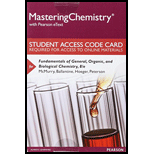
Concept explainers
(a)
Interpretation:
The molecular shape of
Concept introduction:
In a Lewis structure, lines are represented for the bonding between atoms of a molecule and the dots for the lone pairs of electrons that may exist in the molecule.
Molecular shape can be predicted from the Lewis structure by using the valence-shell Electron-pair repulsion (VSEPR) model.
-Draw the Lewis structure.
-Count the number of valence electron pairs (bond pairs and lone pairs).
-Assume that the valence electron pairs form a structure that allows them to be as far away from each other as possible.
-If there are only two valence electron pairs, the molecule is linear.
-If there are three valence electron pairs, the molecule is shaped like an equilateral triangle.
-If there are four valence electron pairs, the molecule is shaped as a regular tetrahedral.
(b)
Interpretation:
The molecular shape of
Concept introduction:
In a Lewis structure, lines are represented for the bonding between atoms of a molecule and the dots for the lone pairs of electrons that may exist in the molecule.
Molecular shape can be predicted from the Lewis structure by using the valence-shell Electron-pair repulsion (VSEPR) model.
-Count the number of valence electron pairs (bond pairs and lone pairs).
-Assume that the valence electron pairs form a structure that allows them to be as far away from each other as possible.
- Multiple bonded atoms located in a plane.
Want to see the full answer?
Check out a sample textbook solution
Chapter 4 Solutions
Mastering Chemistry with Pearson eText -- Standalone Access Card -- for Fundamentals of General, Organic, and Biological Chemistry (8th Edition)
- Write the chemical formula for the conjugate base of each of the following acids: Carbonic Acid (H2CO3)___________________ Formic Acid (CH2O2)_____________________arrow_forwardUse Frost Circles to complete the molecular orbital diagram for cyclooctatetrane. Label the bonding, non bonding, and anti bonding MO’s. If the molecule is planar, would it be aromatic, antiaromatic, or nonaromatic? If the molecule is nonplanar, would it be aromatic, antiaromatic, or nonaromatic?arrow_forwardDraw condensed structural formulas for the two carboxylic acids with the molecular formula C4H8O2arrow_forward
- The structure for 2-chloro-3-heptene is:arrow_forwardNucleus acids are organic compounds. In addition to hydrogen, what element is an essential component of all organic compounds?arrow_forwardWhat prefixes are used in naming the following?(a) A 1,3-disubstituted benzene(b) A 1,4-disubstituted benzenearrow_forward
